What is almond
The almond (Prunus dulcis, syn. Prunus amygdalus) is a species of tree native to the Middle East, the Indian subcontinent and North Africa 1. The almond fruit measures 3.5–6 cm (1–2 in) long. In botanical terms, almond fruit is not a nut but a drupe. The almond fruit drupe, consisting of an outer hull and a hard shell with the seed, which is not a true nut, inside. In botany, a drupe (stone fruits) is an indehiscent fruit in which an outer fleshy part (exocarp or skin; and mesocarp or flesh) surrounds a single shell (the pit or stone) of hardened endocarp with a seed (kernel) inside 2. The definitive characteristic of a drupe is that the hard, “lignified” stone (or pit) is derived from the ovary wall of the flower—in an aggregate fruit composed of small, individual drupes (such as a raspberry) (see Figure 1). Some flowering plants that produce drupes are coffee, jujube, mango, olive, most palms (including date, sabal, coconut and oil palms), pistachio, white sapote, cashew and all members of the genus Prunus, including the almond (in which the mesocarp is somewhat leathery), apricot, cherry, damson, nectarine, peach, and plum.
Shelling almonds refers to removing the shell to reveal the seed. Almonds are sold shelled or unshelled. Blanched almonds are shelled almonds that have been treated with hot water to soften the seedcoat, which is then removed to reveal the white embryo.
- Almond is naturally gluten free.
Figure 1. Drupe fruit diagram
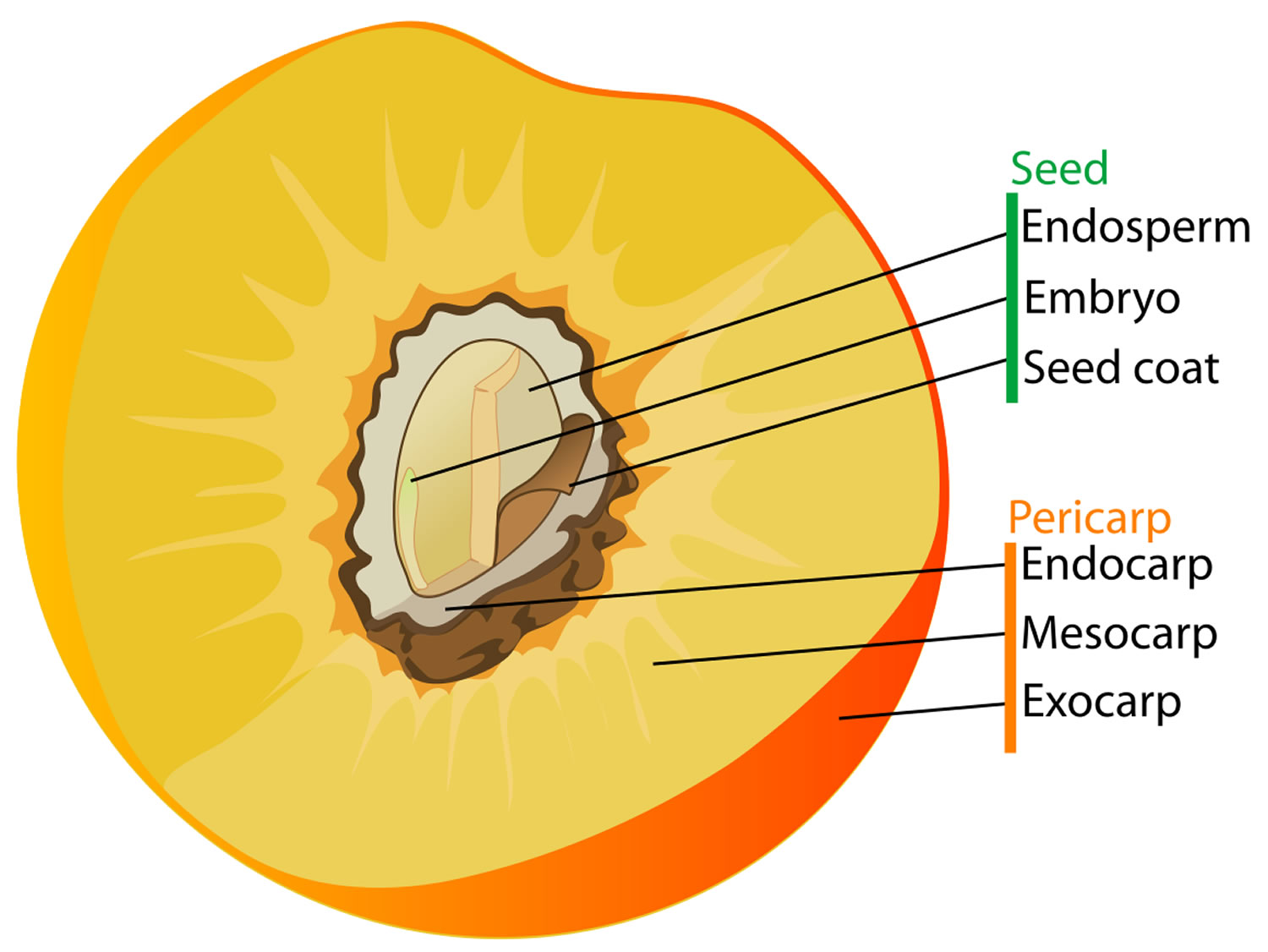
Figure 2. Almond fruit (raw) green
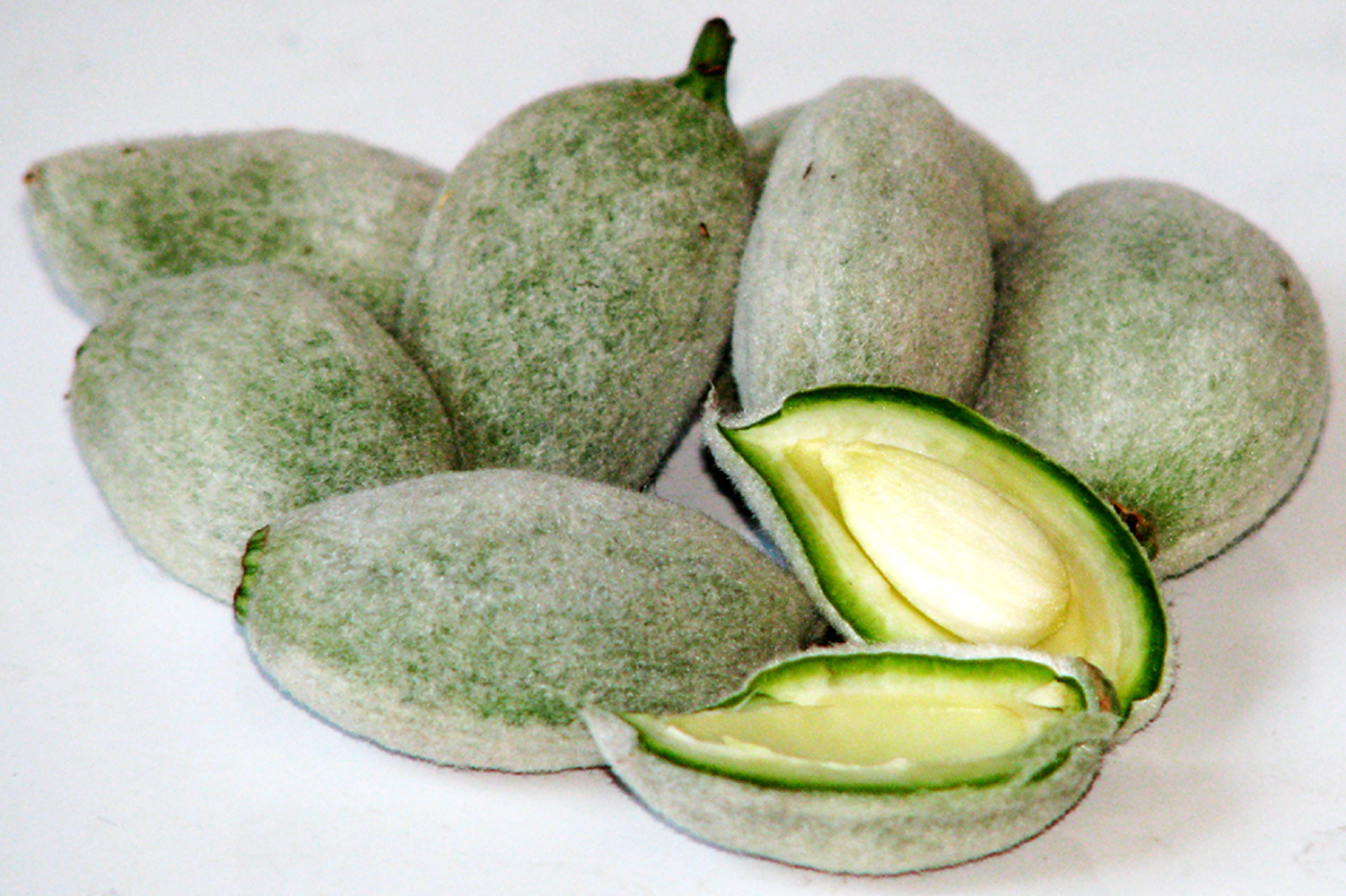
Figure 3. Almonds in tough outer shell

Figure 4. Almonds raw and shelled
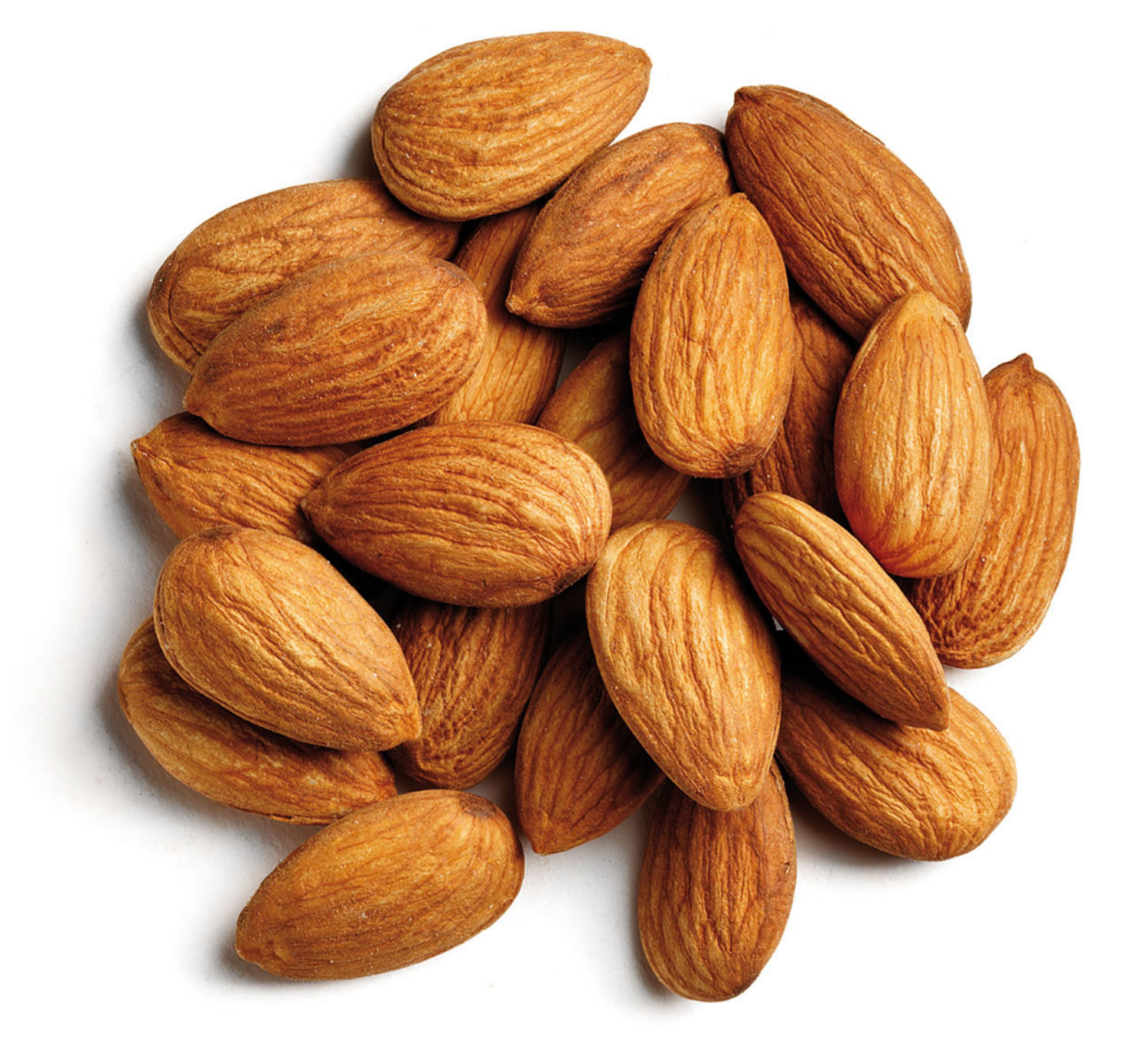
Figure 5. Almonds blanched
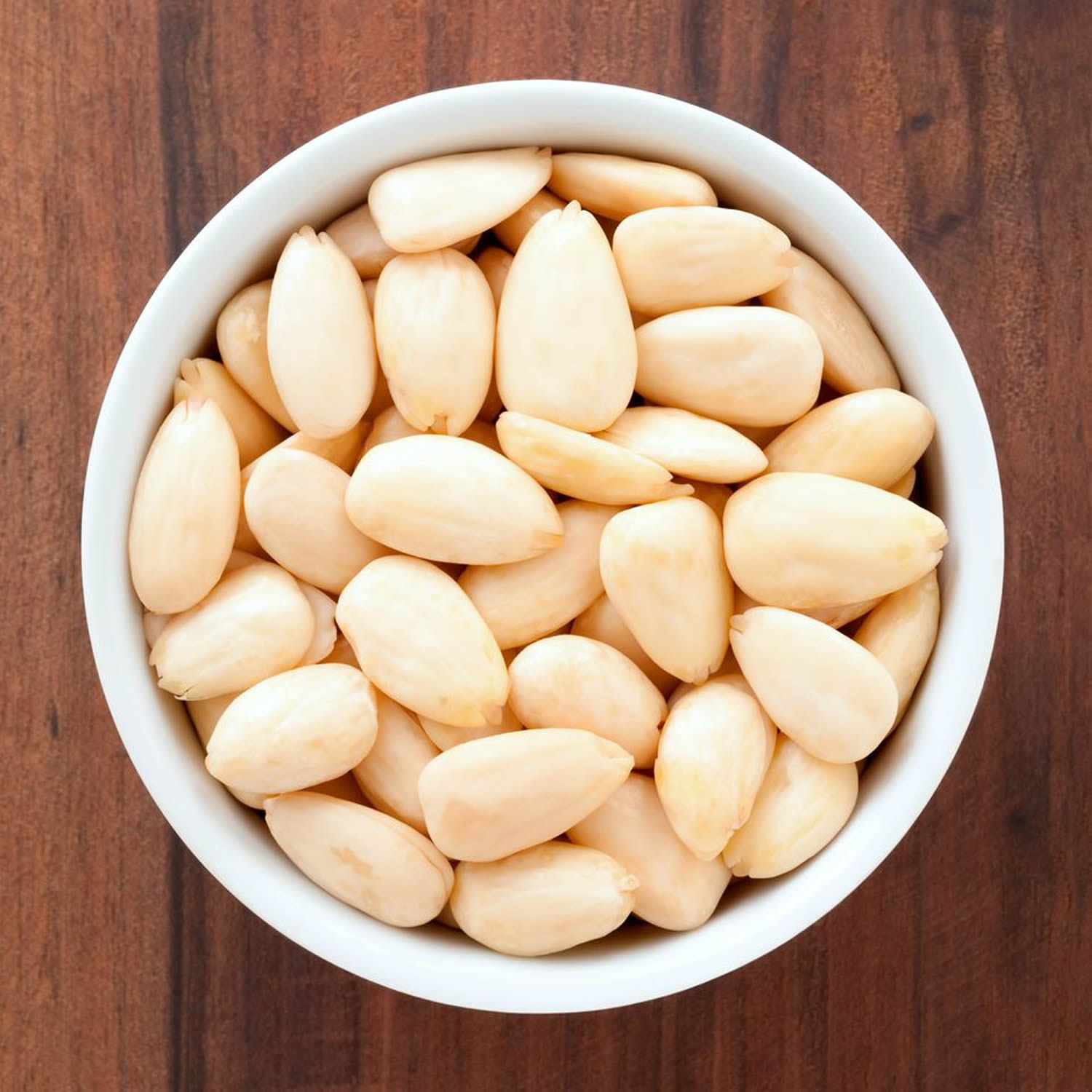
Almond health benefits
Almonds on their own are a good source of protein with a very high proportion of monounsaturated (MUFA) and polyunsaturated fatty acids (PUFA) and a favorable ratio of unsaturated to saturated fatty acids. This ratio, alongside their high alpha-tocopherol (vitamin E) content, has linked almond consumption to benefits such as reduced LDL “bad” cholesterol and reduced cardiovascular risk. Almond oil is rich in oleic acid and linoleic acid and, when added to the diet, increase HDL “good”-cholesterol and reduce LDL “bad” -cholesterol, improve body weight control, and reduce the risk of obesity-related health disorders such as heart disease and type II diabetes 3. Almonds contain between 8.8g – 10.4g/100g of fiber. Almonds contain soluble fiber but a larger proportion is insoluble fiber, also linked with cardiovascular disease protection. For those consuming whole almonds as a snack, the fibrous coat may play a role in nutrient release, satiety and possibly also weight control 4, 5. Current recommendations are to increase dietary fiber and as nuts rank after cereals in their fiber content, they make a valuable contribution to the diet 6.
Almond seeds and oil have anti-inflammatory, immunostimulant effects, and reduce irritable bowel syndrome symptoms, and they are also useful for treating constipation 7. Almond oil has been also used to treat dry skin disorders such as psoriasis and eczema in ancient treatment cultures. Today it is used in aromatherapy massage applications as carrier oil, and also producing many skin-hair cosmetics 8. Hepatoprotective and anticancer activity of almond oil was reported by some in animal research 9. Especially, studies in rats have provided evidence that almond oil is closely associated with reduction in the incidence of colon cancer 10. The specific effects of almond oil with respect to signalling molecules which play a role during tumour viability metastasis, transcription factors and cell proliferation in colon carcinoma cells remain undefined. There are no reports addressing the effect of almond oil on colon cancer with in test tube and in animal studies..
Almonds contain a significant amount of alpha tocopherol (28mg/100g), a recognized antioxidant with the potential to reduce the amount of LDL “bad” cholesterol that are oxidized by free radicals 11. Oxidised LDL “bad” cholesterol may adhere to the endothelial wall and is responsible for the progression of atherosclerosis. The amount of Vitamin E in almonds is higher than other nuts 12 and may potentially contribute to the reduced risk of atherosclerosis development 13. Studies have also documented elevated levels of Vitamin E and increased total plasma antioxidant capacity following consumption of just one handful of almonds 14.
Almonds are also high in beta-sitosterol, a natural phytosterol, which may also assist with the heart health benefits. The potential cardioprotective effects of almonds and their high satiety value reported in the literature suggest that they would make a healthy snack, especially when consumed as whole kernels. Differences in the physical form of ingested almonds in particular, lead to variability in nutrient digestibility and consequently evoke different blood nutrient profiles and gut hormone responses. Comparisons of dry roasted unsalted almonds and raw almonds reveal that the primary differences are in the moisture content, phosphorous and zinc levels, each being lower for the dry roasted almond.
In this study on 100 normal overweight and obese women (BMI > 25 and aged 20-55 years) showed that women who consumed either 50 g almond and no-almond group experienced significant weight reduction after 3-month (−3.68 kg for almond group compared with −1.27 kg no-almond group), but the greater weight-loss in the almond group was significant. Furthermore, the almond group had more reduction in BMI, waist cirumference and waist-hip ratio than the nut-free group, all of which were significant. Interestingly the LDL “bad” cholesterol decreased in both groups over time, but greater reductions in LDL “bad” cholesterol were observed significantly in the no-almond group. Furthermore increase of HDL “good” cholesterol in the almond group was not significant at the end of the study while in the nut-free group, this was significant. Increase of HDL “good” cholesterol in the no-almond group was greater than the almond group. Women who had following criteria were excluded from the study: having a chronic illness (e.g., cancer, renal failure, cardiovascular disease, liver, and lung failure), uncontrolled hypertension (defined as a blood pressure ≥180/100 mmHg), taking lipid-lowering medications or vitamin supplements, an inflammatory condition (e.g., lupus), diabetes or use of anti-hyperglycemic drugs, working night shifts, pregnancy or lactation, smoking, alcohol consumption or any known allergy or sensitivity to nuts.
This study 15 supports the moderating effects of almond consumption on postprandial glycemia observed in a previous study 16. Serum glucose concentrations 60 min after breakfast and lunch meals were lower when 43 g of almonds were ingested with the meals. This may be attributable to the fiber and fat content of almonds. Fiber reduces glycemia by: (a) increasing the viscosity of intestinal contents hindering glucose diffusion; (b) lowering the glucose concentration by reducing carbohydrate availability in the gastrointestinal tract; and (c) capsulation of starch and hence impairing α-amylase activity 17. Fat derived from the almonds may have also caused lower postprandial glycemia by slowing gastric emptying times and dilution 18. The glycemia-lowering-effect of fats is primarily due to a decreased absorption rate rather than an increased clearance from the circulation 19. Furthermore, serum glucose concentrations decreased when almonds were consumed alone as snacks suggesting an enhancement of clearance. Future studies are required to better understand the underlying mechanisms that elevate glucose clearance from the circulation after almond snacks.
In longitudinal studies, almonds have been shown to improve fasting glucose 20, insulin 21 and total and low-density lipoprotein cholesterol 22. However, these effects were not seen in this study 23. A dose-response effect of almonds has been observed in other studies, where higher almond intake was associated with greater lipid and glycemia-lowering effects 24, 25.
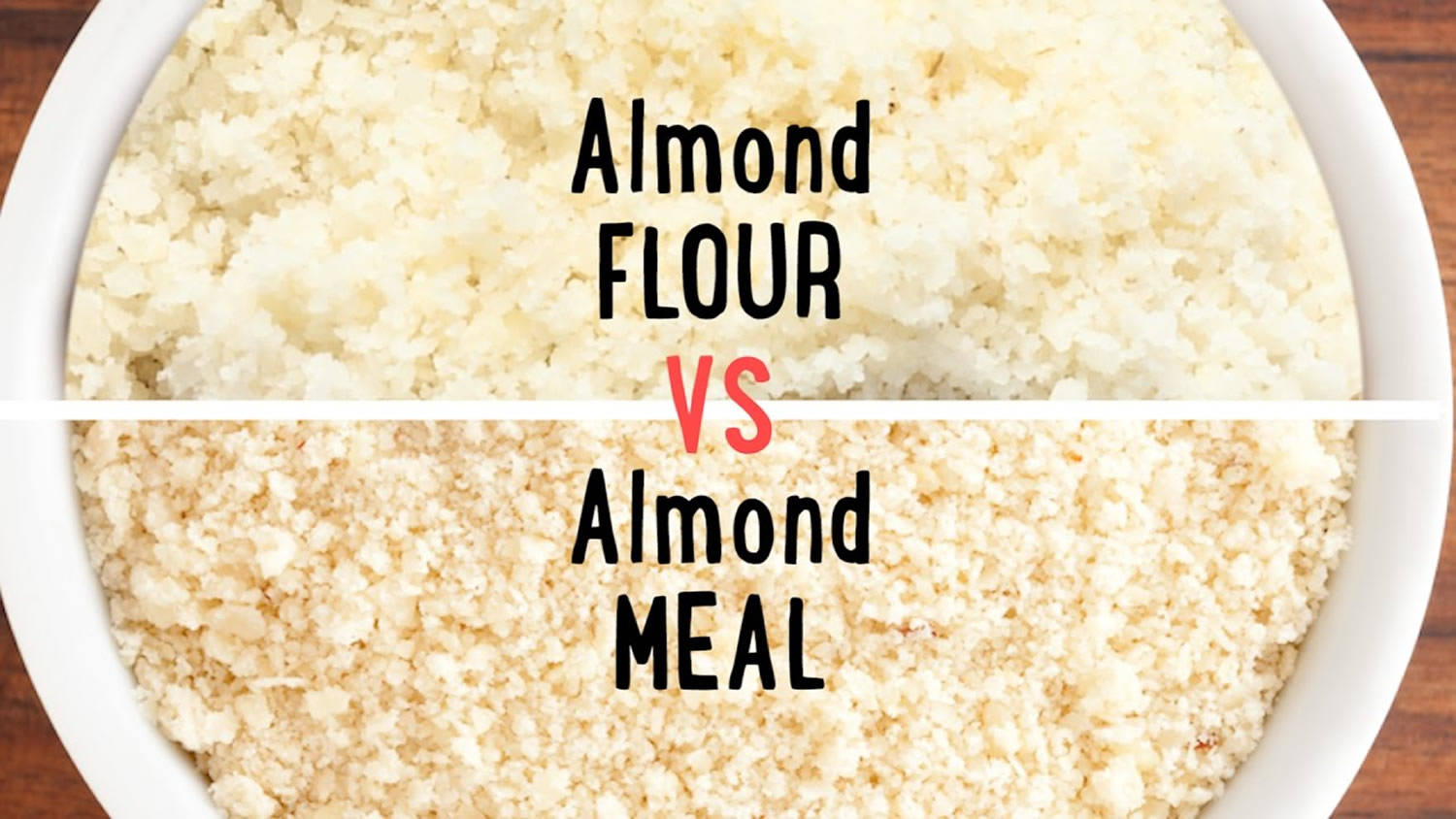
What is almond flour
Almond flour is made with almonds without their skins on which are grounded up into a fine flour. In almond flour, the removal of the almond skin and blanching of the raw almonds, create fine fluffy white color flour. You can use almond flour just like your plain (wheat) flour for baking like cakes and macaroons.
On the other hand, almond meal is typically ground up almonds with their skins on and like cornmeal is a coarse meal. This results in a grain that’s just a bit larger and coarser. You can use almond meal to bake products with a slightly grainy texture.
There is a difference in how the two perform and usually cannot be used interchangeably.
One great thing about recipes using either almond meal or almond flour is that they are more than gluten free, they are grain free as well, making the baked goods suitable for almost anyone (other than those with almond allergies).
Figure 6. Almond flour

Figure 7. Almond meal
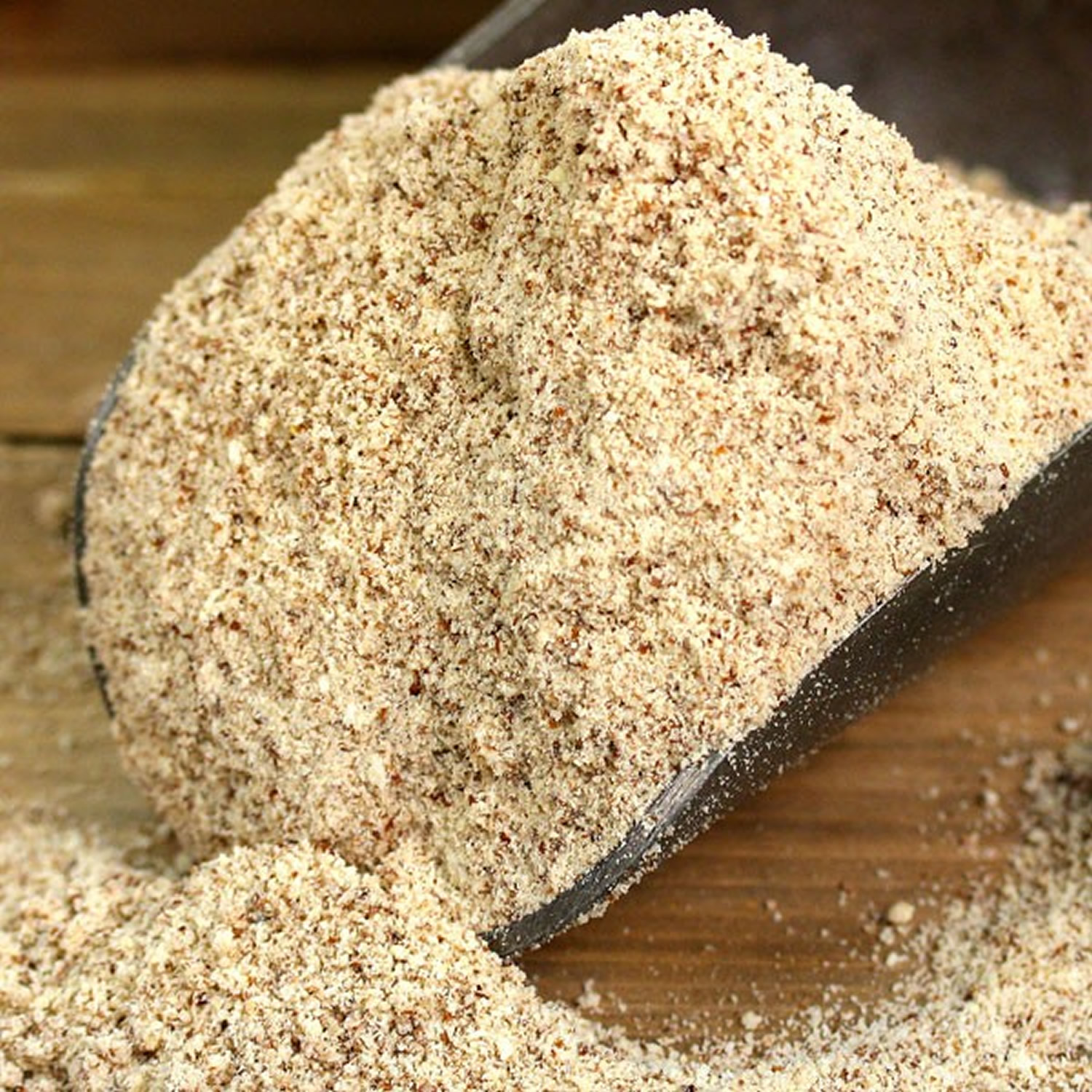
Almond flour nutrition facts
The almond is a nutritionally dense food and a 100 gram (raw almond) amount is a rich source (>20% of the Daily value, DV) of the B vitamins riboflavin and niacin, vitamin E, and the essential minerals calcium, iron, magnesium, manganese, phosphorus, and zinc. The same amount is also a good source (10–19% DV) of the B vitamins thiamine, vitamin B6, and folate; choline; and the essential mineral potassium. They are also rich in dietary fiber, monounsaturated fats, and polyunsaturated fats, fats which potentially may lower LDL cholesterol. Typical of nuts and seeds, almonds also contain phytosterols such as beta-sitosterol, stigmasterol, campesterol, sitostanol, and campestanol, which have been associated with cholesterol-lowering properties.
The contents of available carbohydrates (i.e. mostly sugars) and dietary fibre (i.e. cell walls) in almond kernels are about 5.5% and 11.8%, respectively 26.
Table 1. Almond whole (raw) nutrition facts
| Nutrient | Unit | Value per 100 g |
|---|---|---|
| Approximates | ||
| Water | g | 4.41 |
| Energy | kcal | 579 |
| Energy | kJ | 2423 |
| Protein | g | 21.15 |
| Total lipid (fat) | g | 49.93 |
| Ash | g | 2.97 |
| Carbohydrate, by difference | g | 21.55 |
| Fiber, total dietary | g | 12.5 |
| Sugars, total | g | 4.35 |
| Sucrose | g | 3.95 |
| Glucose (dextrose) | g | 0.17 |
| Fructose | g | 0.11 |
| Lactose | g | 0 |
| Maltose | g | 0.04 |
| Galactose | g | 0.07 |
| Starch | g | 0.72 |
| Minerals | ||
| Calcium, Ca | mg | 269 |
| Iron, Fe | mg | 3.71 |
| Magnesium, Mg | mg | 270 |
| Phosphorus, P | mg | 481 |
| Potassium, K | mg | 733 |
| Sodium, Na | mg | 1 |
| Zinc, Zn | mg | 3.12 |
| Copper, Cu | mg | 1.031 |
| Manganese, Mn | mg | 2.179 |
| Selenium, Se | µg | 4.1 |
| Vitamins | ||
| Vitamin C, total ascorbic acid | mg | 0 |
| Thiamin | mg | 0.205 |
| Riboflavin | mg | 1.138 |
| Niacin | mg | 3.618 |
| Pantothenic acid | mg | 0.471 |
| Vitamin B-6 | mg | 0.137 |
| Folate, total | µg | 44 |
| Folic acid | µg | 0 |
| Folate, food | µg | 44 |
| Folate, DFE | µg | 44 |
| Choline, total | mg | 52.1 |
| Betaine | mg | 0.5 |
| Vitamin B-12 | µg | 0 |
| Vitamin B-12, added | µg | 0 |
| Vitamin A, RAE | µg | 0 |
| Retinol | µg | 0 |
| Carotene, beta | µg | 1 |
| Carotene, alpha | µg | 0 |
| Cryptoxanthin, beta | µg | 0 |
| Vitamin A, IU | IU | 2 |
| Lycopene | µg | 0 |
| Lutein + zeaxanthin | µg | 1 |
| Vitamin E (alpha-tocopherol) | mg | 25.63 |
| Vitamin E, added | mg | 0 |
| Tocopherol, beta | mg | 0.23 |
| Tocopherol, gamma | mg | 0.64 |
| Tocopherol, delta | mg | 0.07 |
| Vitamin D (D2 + D3) | µg | 0 |
| Vitamin D | IU | 0 |
| Vitamin K (phylloquinone) | µg | 0 |
| Lipids | ||
| Fatty acids, total saturated | g | 3.802 |
| 8:0 | g | 0 |
| 10:0 | g | 0 |
| 12:0 | g | 0 |
| 13:0 | g | 0 |
| 14:0 | g | 0.003 |
| 15:0 | g | 0 |
| 16:0 | g | 3.083 |
| 17:0 | g | 0.004 |
| 18:0 | g | 0.704 |
| 20:0 | g | 0.007 |
| 22:0 | g | 0.001 |
| 24:0 | g | 0 |
| Fatty acids, total monounsaturated | g | 31.551 |
| 14:1 | g | 0 |
| 15:1 | g | 0 |
| 16:1 undifferentiated | g | 0.239 |
| 16:1 c | g | 0.227 |
| 16:1 t | g | 0.012 |
| 17:1 | g | 0.013 |
| 18:1 undifferentiated | g | 31.294 |
| 18:1 c | g | 31.294 |
| 18:1 t | g | 0 |
| 20:1 | g | 0.005 |
| 22:1 undifferentiated | g | 0 |
| 24:1 c | g | 0 |
| Fatty acids, total polyunsaturated | g | 12.329 |
| 18:2 undifferentiated | g | 12.324 |
| 18:2 n-6 c,c | g | 12.32 |
| 18:2 CLAs | g | 0.002 |
| 18:2 t not further defined | g | 0.003 |
| 18:3 undifferentiated | g | 0.003 |
| 18:3 n-3 c,c,c (ALA) | g | 0.003 |
| 18:3 n-6 c,c,c | g | 0 |
| 18:04:00 | g | 0 |
| 20:2 n-6 c,c | g | 0.002 |
| 20:3 undifferentiated | g | 0 |
| 20:4 undifferentiated | g | 0 |
| 20:5 n-3 (EPA) | g | 0 |
| 22:5 n-3 (DPA) | g | 0 |
| 22:6 n-3 (DHA) | g | 0 |
| Fatty acids, total trans | g | 0.015 |
| Fatty acids, total trans-monoenoic | g | 0.012 |
| Cholesterol | mg | 0 |
| Stigmasterol | mg | 4 |
| Campesterol | mg | 5 |
| Beta-sitosterol | mg | 130 |
| Amino Acids | ||
| Tryptophan | g | 0.211 |
| Threonine | g | 0.601 |
| Isoleucine | g | 0.751 |
| Leucine | g | 1.473 |
| Lysine | g | 0.568 |
| Methionine | g | 0.157 |
| Cystine | g | 0.215 |
| Phenylalanine | g | 1.132 |
| Tyrosine | g | 0.45 |
| Valine | g | 0.855 |
| Arginine | g | 2.465 |
| Histidine | g | 0.539 |
| Alanine | g | 0.999 |
| Aspartic acid | g | 2.639 |
| Glutamic acid | g | 6.206 |
| Glycine | g | 1.429 |
| Proline | g | 0.969 |
| Serine | g | 0.912 |
| Other | ||
| Alcohol, ethyl | g | 0 |
| Caffeine | mg | 0 |
| Theobromine | mg | 0 |
| Anthocyanidins | ||
| Cyanidin | mg | 2.46 |
| Petunidin | mg | 0 |
| Delphinidin | mg | 0 |
| Malvidin | mg | 0 |
| Pelargonidin | mg | 0 |
| Peonidin | mg | 0 |
| Flavan-3-ols | ||
| (+)-Catechin | mg | 1.3 |
| (-)-Epigallocatechin | mg | 2.6 |
| (-)-Epicatechin | mg | 0.6 |
| (-)-Epicatechin 3-gallate | mg | 0 |
| (-)-Epigallocatechin 3-gallate | mg | 0 |
| (+)-Gallocatechin | mg | 0 |
| Flavanones | ||
| Eriodictyol | mg | 0.2 |
| Hesperetin | mg | 0 |
| Naringenin | mg | 0.4 |
| Flavones | ||
| Apigenin | mg | 0 |
| Luteolin | mg | 0 |
| Flavonols | ||
| Isorhamnetin | mg | 2.6 |
| Kaempferol | mg | 0.4 |
| Myricetin | mg | 0 |
| Quercetin | mg | 0.4 |
| Isoflavones | ||
| Daidzein | mg | 0 |
| Genistein | mg | 0.01 |
| Glycitein | mg | 0 |
| Total isoflavones | mg | 0.01 |
| Formononetin | mg | 0 |
| Coumestrol | mg | 0.02 |
| Proanthocyanidin | ||
| Proanthocyanidin dimers | mg | 9.3 |
| Proanthocyanidin trimers | mg | 7.6 |
| Proanthocyanidin 4-6mers | mg | 27.4 |
| Proanthocyanidin 7-10mers | mg | 28.2 |
| Proanthocyanidin polymers (>10mers) | mg | 80.3 |
Table 2. Almond flour (100% blanched) nutrition facts
| Nutrient | Unit | cup 28 g | Value per 100 g | |
|---|---|---|---|---|
| Approximates | ||||
| Energy | kcal | 170 | 607 | |
| Protein | g | 6 | 21.43 | |
| Total lipid (fat) | g | 15 | 53.57 | |
| Carbohydrate, by difference | g | 5 | 17.86 | |
| Fiber, total dietary | g | 3 | 10.7 | |
| Sugars, total | g | 1 | 3.57 | |
| Minerals | ||||
| Calcium, Ca | mg | 60 | 214 | |
| Iron, Fe | mg | 1.93 | 6.88 | |
| Magnesium, Mg | mg | 143 | 510 | |
| Potassium, K | mg | 180 | 643 | |
| Sodium, Na | mg | 5 | 18 | |
| Vitamins | ||||
| Vitamin C, total ascorbic acid | mg | 0 | 0 | |
| Vitamin A, IU | IU | 0 | 0 | |
| Lipids | ||||
| Fatty acids, total saturated | g | 1 | 3.57 | |
| Fatty acids, total monounsaturated | g | 8.999 | 32.14 | |
| Fatty acids, total polyunsaturated | g | 3.5 | 12.5 | |
| Fatty acids, total trans | g | 0 | 0 | |
| Cholesterol | mg | 0 | 0 | |
Table 3. Almond meal nutrition facts
| Nutrient | Unit | cup 30 g | Value per 100 g | |
|---|---|---|---|---|
| Approximates | ||||
| Energy | kcal | 180 | 600 | |
| Protein | g | 6 | 20 | |
| Total lipid (fat) | g | 16 | 53.33 | |
| Carbohydrate, by difference | g | 6 | 20 | |
| Fiber, total dietary | g | 3 | 10 | |
| Sugars, total | g | 1 | 3.33 | |
| Minerals | ||||
| Calcium, Ca | mg | 80 | 267 | |
| Iron, Fe | mg | 1.8 | 6 | |
| Sodium, Na | mg | 0 | 0 | |
| Vitamins | ||||
| Vitamin C, total ascorbic acid | mg | 0 | 0 | |
| Vitamin A, IU | IU | 0 | 0 | |
| Lipids | ||||
| Fatty acids, total saturated | g | 0.999 | 3.33 | |
| Fatty acids, total monounsaturated | g | 9.999 | 33.33 | |
| Fatty acids, total polyunsaturated | g | 3.501 | 11.67 | |
| Fatty acids, total trans | g | 0 | 0 | |
| Cholesterol | mg | 0 | 0 | |
Table 4. Main processing techniques and their effects on the chemical composition, structure and properties of almonds
| Processing | Effect on almond structure and composition |
|---|---|
| Roasting | Water loss Cell wall damage Changes in the cytoplasmic network Loss in oil body integrity (i.e. lipid coalescence) Distortion and aggregation of protein bodies Browning of the almond tissue due to Maillard reaction Lipid uptake (when oil used during roasting) |
| Blanching | Alteration in cytoplasmic organization Skin removal which leads to loss in some micronutrients (e.g. phenolic compounds) Water uptake |
| Particle size reduction | Rupture of cell walls particularly on the surface of the almond particle Release of some of the nutrients |
| Oil extraction | Degradation of the almond tissue to extract the oil Loss in oil body integrity |
- Almond. Wikipedia. https://en.wikipedia.org/wiki/Almond
- Stern, Kingsley R. (1997). Introductory Plant Biology (Seventh ed.). Dubuque: Wm. C. Brown. ISBN 0-07-114448-X.
- Damesceno NRT, Peres-Heras A, Serra M, Cofan M, Sala-Vila A, Salas-Salvode, Ros E. 2011. Crossover study of diets enriched with virgin olive oil, walnuts or almonds. Effects on lipids and other cardiovascular risk marker. Nutr Metabol Cardiovasc Dis. 21:14–20.
- Mandalari G R, Faulks RM, Rich GT, Turco VL, Picout DR, Lo Curto RB, et al. Release of Protein, Lipid, and Vitamin E from Almond Seeds during Digestion. Journal of Agricultural and Food Chemistry 2008;56:3409-3416.
- Fraser GE, Bennett HW, Jaceldo KB, Sabaté J. Effect on Body Weight of a Free 76 Kilojoule (320 Calorie) Daily Supplement of Almonds for Six Months. Journal of the American College of Nutrition 2002;21(3):275-283.
- NHMRC. Nutrient Reference Values for Australia and New Zealand. In: The Australian Government, editor. Canberra, 2006.
- Zeeshan A. 2010. The uses and properties of almond oil. Compliment Ther Clin Prac. 16:10–12. https://www.ncbi.nlm.nih.gov/pubmed/20129403
- Buckle J. 2002. Clinical Aromatherapy. Therapeutic uses for essential oils. Adv Nurse Pract. 10:67–68. https://www.ncbi.nlm.nih.gov/pubmed/12420533
- Jia XY, Zhang QA, Zhang ZQ, Wang Y, Yuan JF, Wang HY, Zhao D. 2011. Hepatoprotective effects of almond oil against carbontetrachloride induced liver injury rats. Food Chem. 125:673–678.
- Davis PA, Iwahashi CK. 2001. Whole almonds and almond fractions reduce aberrant crypt foci in a rat model of colon carcinogenesis. Cancer Lett. 165:27–33. https://www.ncbi.nlm.nih.gov/pubmed/11248415
- Food Standards Australia New Zealand. NUTTAB 2006 Online version, 2007
- Griel AE, Kris-Etherton PM. Tree nuts and the lipud profile: a review of clinical studies. British Journal of Nutrition 2006;96(Suppl 2):S68-S78.
- Spiller G, Miller A, Olivera K, Reynolds J, Miller B, Morse S, et al. Effects of plant-based diets high in raw or roasted almonds, or roasted almond butter on serum lipoproteins in humans. Journal of the American College of Nutrition 2003;22(3):195-200.
- Jambazian PR, Haddad E, Rajaram S, Tanzman J, Sabaté J. Almonds in the diet simultaneously improve plasma alpha-tocopherol concentrations and reduce plasma lipids. Journal of the American Dietetic Association 2005;105(3):449-54.
- Tan SY, Mattes RD. Appetitive, dietary and health effects of almonds consumed with meals or as snacks: a randomized, controlled trial. European Journal of Clinical Nutrition. 2013;67(11):1205-1214. doi:10.1038/ejcn.2013.184. https://www.ncbi.nlm.nih.gov/pmc/articles/PMC3898316/
- Almond ingestion at mealtime reduces postprandial glycemia and chronic ingestion reduces hemoglobin A(1c) in individuals with well-controlled type 2 diabetes mellitus. Cohen AE, Johnston CS. Metabolism. 2011 Sep; 60(9):1312-7. https://www.ncbi.nlm.nih.gov/pubmed/21489570/
- Ou S, Kwok K-c LiY, Fu L. In vitro study of possible role of dietary fiber in lowering postprandial serum glucose. J Agric Food Chem. 2001;49:1026–1029. https://www.ncbi.nlm.nih.gov/pubmed/11262066
- Collier G, O’Dea K. The effect of coingestion of fat on the glucose, insulin, and gastric inhibitory polypeptide responses to carbohydrate and protein. Am J Clin Nutr. 1983;37:941–944. https://www.ncbi.nlm.nih.gov/pubmed/6342357
- Influence of dietary fat on postprandial glucose metabolism (exogenous and endogenous) using intrinsically (13)C-enriched durum wheat. Normand S, Khalfallah Y, Louche-Pelissier C, Pachiaudi C, Antoine JM, Blanc S, Desage M, Riou JP, Laville M. Br J Nutr. 2001 Jul; 86(1):3-11. https://www.ncbi.nlm.nih.gov/pubmed/11432759/
- Lovejoy JC, Most MM, Lefevre M, Greenway FL, Rood JC. Effect of diets enriched in almonds on insulin action and serum lipids in adults with normal glucose tolerance or type 2 diabetes. Am J Clin Nutr. 2002;76:1000–1006. https://www.ncbi.nlm.nih.gov/pubmed/12399271
- Jenkins DJA, Kendall CWC, Marchie A, Josse AR, Nguyen TH, Faulkner DA, et al. Effect of almonds on insulin secretion and insulin resistance in nondiabetic hyperlipidemic subjecys: a randomized controlled crossover trial. Metabolism. 2008;57:882–887. https://www.ncbi.nlm.nih.gov/pubmed/18555827
- Jenkins DJA, Kendall CWC, Marchie A, Josse AR, Nguyen TH, Faulkner DA, et al. Almonds reduce biomarkers of lipid peroxidation in older hyperlipidemic subjects. J Nutr. 2008;138:908–913. http://jn.nutrition.org/content/138/5/908.long
- Tan SY, Mattes RD. Appetitive, dietary and health effects of almonds consumed with meals or as snacks: a randomized, controlled trial. European Journal of Clinical Nutrition. 2013;67(11):1205-1214. doi:10.1038/ejcn.2013.184. https://www.ncbi.nlm.nih.gov/pmc/articles/PMC3898316/
- Sabate J, Haddad E, Tanzman J, Jambazian PR, Rajaram S. Serum lipid response to the graduated enrichment of a Step I diet with almonds: a randomized feeding trial. Am J Clin Nutr. 2003;77:1379–1384. http://ajcn.nutrition.org/content/77/6/1379.long
- Josse AR, Kendall CWC, Augustin LSA, Ellis PR, Jenkins DJA. Almonds and postprandial glycemia—a dose-response study. Metab Clin Exp. 2007;56:400–404. https://www.ncbi.nlm.nih.gov/pubmed/17292730
- Ellis P.R., Kendall C.W., Ren Y. et al (2004). Role of cell walls in the bioaccessibility of lipids in almond seeds. American Journal of Clinical Nutrition, 80, 604–613. http://ajcn.nutrition.org/content/80/3/604.long
- United States Department of Agriculture Agricultural Research Service. USDA Branded Food Products Database. https://ndb.nal.usda.gov/ndb/search/list
- Grundy MM, Lapsley K, Ellis PR. A review of the impact of processing on nutrient bioaccessibility and digestion of almonds. International Journal of Food Science & Technology. 2016;51(9):1937-1946. doi:10.1111/ijfs.13192. https://www.ncbi.nlm.nih.gov/pmc/articles/PMC5003169





